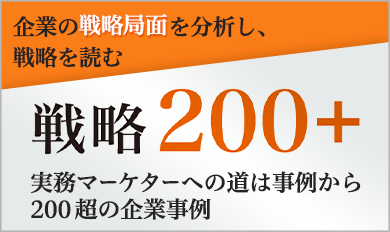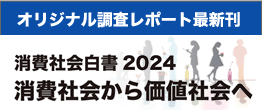
The women who enjoy Noon-Katsu during Afternoon Tea
Afternoon Tea - It's where the women enjoy an elegant time over tea, surrounded by a spread of cute desserts and light fare. In recent years this has come to be called Noon-Katsu*1 , and it's trending among women. Even during the pandemic which has not yet fully left us, hotels and other businesses offering Afternoon Tea are very popular, so much so that they are booked far in advance. In the results of an our survey we found the market size in Japan of Afternoon Tea to be approximately 265.2 billion yen, which was much larger than what we had expected.
For this report, we will estimate the market size of Afternoon Tea, review the background covering the need for afternoon leisure activities between 11:00 and 17:00, verify the activities by women who have kept Afternoon Tea popular, and analyze the business conditions at luxury hotels in the metropolitan Tokyo area (hereinafter, MLH). We consider whether the Afternoon Tea market come to the rescue of hotels on the brink of failure? We also want to find out what lessons consumer goods makers in different industries can learn from this effort to win over the hearts of women. All of contents in the survey are based upon the responses collected by JMR from 5,963 women in Japan (January 2022, ages 20~69).
Firstly, we estimated the market size of Afternoon Tea. The estimated size of the market of users of Afternoon Tea (including hotels and similar businesses) in Japan is approximately 265.2 billion yen. The Tokyo metropolitan area, comprised of 3 prefectures, totals approximately 87.2 billion yen. The core market of Tokyo by itself accounts for approximately 31.9 billion yen. This is no different than the market size of a popular brand of consumer goods. Thus a hotel manager can see that this market size is big enough to be considered as a single menu item for a restaurant. However, to keep optimism in check before we look more deeply we cannot immediately say whether the impact from Afternoon Tea alone is the solution to get the hotel industry back on a brighter track.
The market size of Afternoon Tea in Japan for the 15 MLH is 21.9 billion yen. This includes the 10.8 billion yen for the three-prefecture greater Tokyo metropolitan area (hereinafter, TPA) as well as core Tokyo which accounts for 5.9 billion yen. Fifteen hotels account for 18.5% of Tokyo's market size, and their contribution is high. However, recently the restaurants and cafes in town are offering alternative Afternoon Tea venues. This phenomenon is not limited to only establishments that offer western cuisine. This has spread to Japanese restaurants, Indian restaurants, and to bars. So, the hotels are challenged to respond this phenomenon too (Figure 1-1).
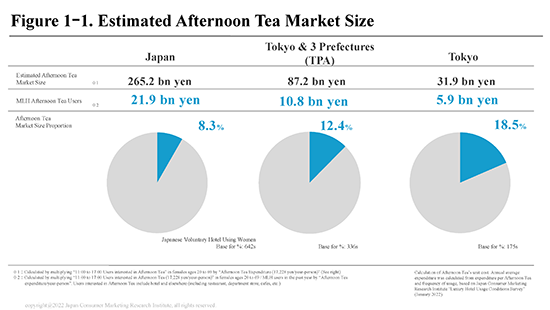
Afternoon Tea is popular among women because they are "looking to enjoy their personal hours". They want to eat out, chat with friends, enjoy Afternoon Tea, or enjoy shopping. JMR surveyed the market size for when ladies want to enjoy their personal hours in these ways, which is during the day from 11:00 to 17:00 (Figure 1-2).
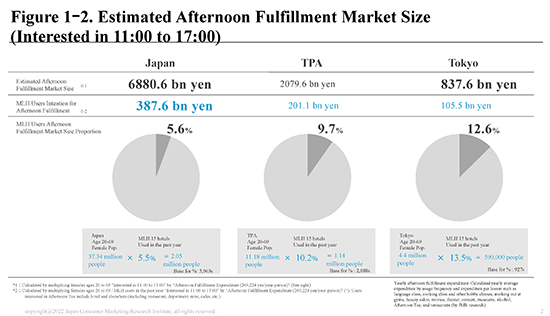
The market size of when they are looking to enjoy their personal hours, 11:00 to 17:00, in Japan is 6.88 trillion yen. 2.796 trillion yen in the TPA, and 837.6 billion yen in Tokyo. For reference, the market size of other industries, such as home electronics, drug stores, metal products, games, and semiconductors amount to 6 to 7 trillion yen. Thus it is a giant market that businesses can not afford to overlook.
The Japan market size for those who have used MLH in the last year (including hotel stays) is 397.6 billion yen (2.05 million persons). This is 201.1 billion yen (1.14 million persons) in the TPA, and 105.5 billion yen (590,000 persons) in Tokyo. Notice that the time during the day when MLH users are looking to enjoy their personal time increases as we move from a nationwide focus to a the more narrowly focused are of just core Tokyo. This means that there is room for MLH to develop strategies to capture this female market more effectively. By understanding the needs of this female target segment - those looking to enjoy their personal hours between 11:00 to 17:00, MLH has the potential to capture a 201.1 billion yen of demand in the TPA.
Noon-Katsu Women's Activities Today
When do the women flock to Afternoon Tea, what are the triggers, and what are they looking to enjoy. This report will review the user personal profiles of experienced female MLH users in Japan (Figure 1-3).
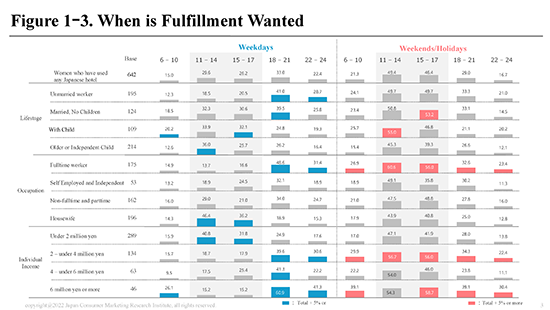
Firstly, when we consider the proportion of their time that they are looking to enjoy in terms of whether this is on a weekday or weekend/holiday, weekend/holiday.
Overall, there is no significant variance between the hours of 11:00 to 17:00 on weekends/holidays. However during lunchtime it is by and large women with children that seek to use the earlier time frames. Meanwhile the later afternoon times are more popular with unmarried women and/or without children. When viewed by occupation they are women who work fulltime, and by income they are women who earn 2 to not more than 4 million yen per year.
It is proportionately women with older children and children who have left home and women with small children and housewives who come during 11:00 to 17:00 on weekdays, and many have an income of under 2 million yen per year. After 18:00, they were mostly unmarried workers, married with no children, and fulltime workers. Many in this group have annual incomes of 6 million yen or more.
This means that activities to enjoy the afternoon on a weekend/holiday are performed by fulltime workers who want to enjoy their weekend to the fullest. And it is mostly housewives who engage in activities to enjoy the afternoon on weekdays, and this is the group that is looking for enjoyment during the hours when they do not need to look after their children, or during their free hours because their children no longer need looking after.
Next, what, when and where do women want their leisure relaxing hours.? We will review the women who want to enjoy their hours between 11:00 and 17:00 by attribute (Figure 1-4).
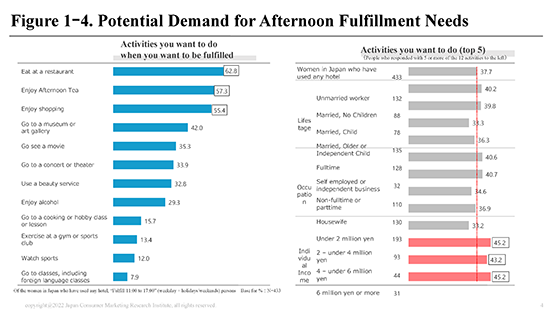
The top three results were: in first place was eating at restaurants (62.8%), in second place was enjoying Afternoon Tea (57.3%), and in third place was enjoying shopping (55.4%). Even when viewed by attribute, there was no significant variance overall among those who responded with five or more activities that they want to do. However we speculate that there is a general correlation between timing and financial resources available to fulfill these activities.
Capture levels at the MLH
How many of these available markets has MLH been able to capture to date.
We reviewed the usage levels at the MLH based upon women residents in TPA (Figure 1-5).
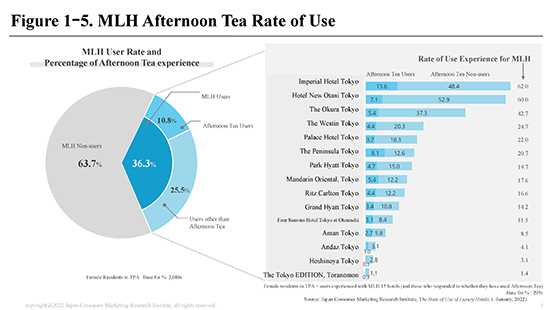
Women who have used MLH represented 36.3% of all women. The breakdown was -- 25.5% were women who have stayed there or have eaten lunch and/or dinner, that is, not related to Afternoon Tea services, and 10.8% were women who have used the Afternoon Tea services.
Next, we will review their usage rate by hotel. The hotel usage rate overall is dominated by the three traditional Big Players. The Peninsula Tokyo had an Afternoon Tea usage rate of 8.1% which is higher than the two other traditional Big Players. We conjecture that Afternoon Tea at The Peninsula Tokyo is more popular and viewed as trendier. The Peninsula is known as the pioneer of the 5.9 billion yen Afternoon Tea market.
We have reviewed three cases of Afternoon Tea with the highest reviews.
Imperial Hotel
Strawberry Pink Afternoon Tea. 7,150 yen (tax included, service charge not included). Period: February 1, 2022, Tuesday, to March 25, 2022, Friday.
Afternoon Tea - Peter Rabbit's Birthday. 7,700 yen (tax included, service charge not included). Period: March 26, 2022, Saturday, to June 30, 2022, Thursday.
This plan is described as seasonal strawberry sweets that is regularly popular with women. Their special value added is to prepare the special desserts at the table in front of the dinner. This is meant to create a surprise element. Imperial Hotel is known for their live shows which they use to communicate with their customers. They also differentiate themselves by collaboration with a secret character for their next Afternoon Tea.
Hotel New Otani
New Afternoon Tea Set - Amaou - 6,820 yen (tax included, service charge not included). Period: Till May 8, 2022, Sunday.
Using seasonal fruits, the New Afternoon Tea Set attempts to be different from the original Super Sweets Series adopted by the Hotel New Otani. The Super Sweets Series is a product that is focused on taste and healthiness, made from carefully selected ingredients and materials, and soy milk cream.
The Peninsula Tokyo
Strawberry Afternoon Tea. 7,337 yen (tax and service charge included). Period: December 26, 2021, Sunday till March 14, 2022, Monday.
This is The Peninsula Tokyo's standard seasonal menu that can be enjoyed not only at their lounge but at both eating areas. Take-out is also possible. Through flexibility, they offer many opportunities for customer contact. It's Afternoon Tea service attempts to project the elegance and refinement of Hong Kong when it was a British colony. The effect makes it popular with customers looking for a more authentic style of Afternoon Tea.
So we need to consider whether the best solution if to focus on the further development of Afternoon Tea services; or would it be possible to get clients to use existing hotel facilities. We surveyed clients at 5 random hotels on their views on their future accommodation intentions (Figure 1-6).
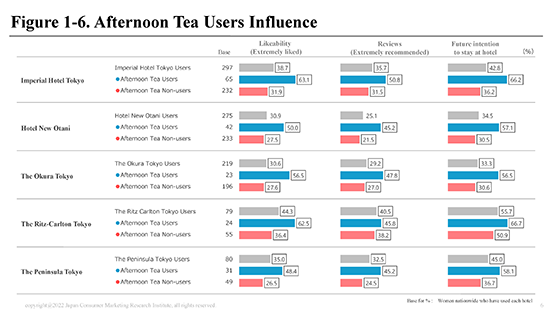
Among the people with experience with each hotel, the table is divided between people with experience using Afternoon Tea and those without experience using Afternoon Tea, and measures likeability, reviews, and future accommodation intention. Among these five hotels, the Imperial Hotel had the highest likeability and reviews from Afternoon Tea users. The Ritz-Carlton Tokyo was the hotel where Afternoon Tea usage tied in the most with future intention to use their accommodation. As a whole, the chart numbers reveal that Afternoon Tea users have a large influence on likeability, reviews, and future accommodation intention.
Survival of MLH under Threat
There is a possibility that Afternoon Tea strategies may generate a larger market than initially imagined. Furthermore, JMR's research revealed that an Afternoon Tea approach is effective in uncovering true hotel accommodation intentions. MLH have captured Tokyo's 5.9 billion yen Afternoon Tea market, but much like hotels elsewhere in the world they have been hard hit by Covid-19. Does capturing this Afternoon Tea demand have the value of reviving the business? Firstly, let's consider the data from JMR's research team about business conditions and performed an analysis.
Firstly, we looked at the usage experience rate among women in TPA for each hotel (Figure 2-1). As a whole, 36% are people with MLH usage experience. Among those, 5.8% have booked accommodation in the last year, 14.9% have experience with accommodation (not including within the last year), 15.6% are people who have experience with dining and drinking but not with accommodations. By MLH, the three formerly Big Players account for the top three percentages in usage experience.
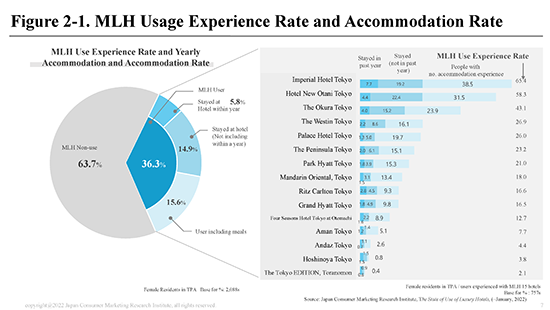
Here we used AMTUL to analyze the usage experience and accommodation rates (Figure 2-2).
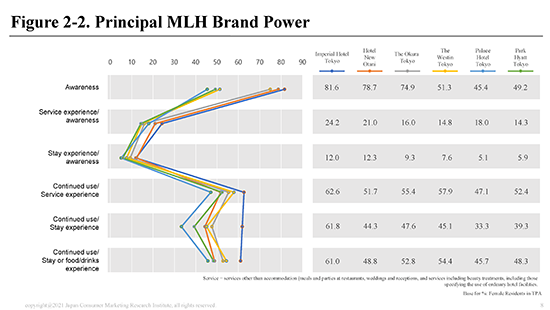
Recognition is highest for the three formerly Big Players in hotels. Although the yield from recognition to service experience and accommodation experience is small, ongoing usage from service experience and accommodation experience shows a high numerical value. Furthermore, high levels of recognition are not always connected to high rate of ongoing usage. In the formation of goodwill towards MLH brands, experiencing the brand is essential.
For MLH, we have looked at what kind of value there is in capturing the Afternoon Tea market. Next, we will estimate the level of MLH sales and explore economic significance.
This estimate is divided into three factors: 1. The Present Covid-19 Crisis, 2. Future Recovery Timing for Domestic Demand and 3. Future Recovery Timing for Inbound Tourism (Figure 2-3).
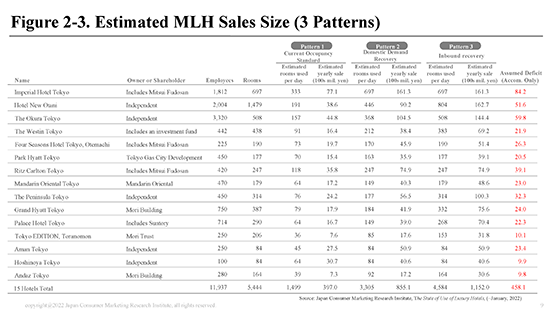
As for the present Covid-19 crisis, yearly sales for a total of 15 hotels were 39.7 billion yen. In the event domestic demand recovers, this would rise to 85.5 billion yen. In the event inbound tourism recovers, we estimate that this will be 115.2 billion yen. Assuming an occupancy rate of 60.7% when domestic demand recovers, in a profitable state of affairs, then at present this would represent a 45.8 billion yen deficit.
Next, we applied a supply-demand analysis of the above MLH sales and deficit conditions from the perspective of an economic analysis. A supply-demand analysis is an analysis in which the price equilibrium is for a product, using the supply and demand curves. Using this, we were able to provide an objective long-term analysis of the MLH market, but this kind of analysis for the hotel industry is not regularly performed.
Demand was estimated as a downward right-declining curve based on the results of the earlier survey, and supply was estimated as an upward-right-inclining curve after the average cost was calculated for each hotel based on their number of rooms. If the market has adequate competition, our hypothesis is that the market will adjust supply and demand based on price.
(1)Present Covid-19 Crisis
Next we turn our attention to explaining the supply-demand situation for hotel rooms in the present Covid-19 crisis.
Estimating based on the average occupancy rate for city hotels in 2020 to 2021 as published by the Japan Tourism Agency, occupancy among all rooms of 15 hotels comes to approximately 1,500 rooms per day and when compared to accommodation demands prior to the Covid-19 crisis, this is a sharp reduction of approximately 32.7%. In terms of supply the total available rooms for accommodation is 5,444, which means that there is an oversupply of about just under 4,000 rooms per day. This is the present level of supply in the market, with prices at around 10,000 yen. However, the average asking price for accommodation is 55,443 yen for the 15 hotels as of February 2, 2022, which is more than 5 times and because of this there can't be any equilibrium based on price. It is believed that this deviation will be adjusted by competition. According to this supply-demand curve, we can say that the situation is unstable as 15 hotels are competing to fill approximately 1,500 rooms and thus enter a price war situation.
If a seriously low-price competition starts, then the only survivor would be Hotel New Otani, which has the lowest fixed cost and is able to sell rooms at the lowest prices.
In the current situation, if a hotel is willing to make a loss, either short-term or mid-term, in order to survive, there is room for price reduction between the average price now of 55,443 yen and New Otani's approximately price of 10,000 yen. To make even a little bit of profit, other hotels are differentiating themselves by adding 30% or more in value to the lowest price of rooms, and it's becoming a competition for how to win those 1,500 rooms.
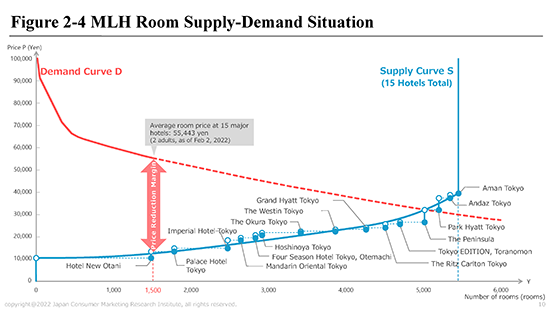
(2)Future Recovery Timing for Domestic Demand
Next, in the event movement restrictions are eased and domestic demand recovers (Figure 2-5).
Assuming an average occupancy rate, we predict a demand of approximately 5,000 rooms. In that case, the MLH market's accommodation price will be adjusted to supply and demand by about 32,000 yen and in a price competition the forecast is that 12 companies will survive and three will not. Park Hyatt Tokyo, Andaz Tokyo and Aman Tokyo will not engage in a price competition, and instead provide original and differentiating services. They must narrow down their customer base, set a clear target, and market to this target efficiently.
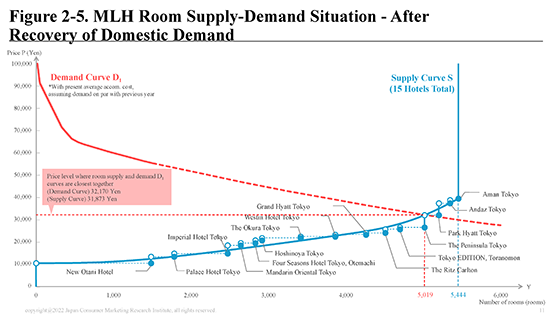
(3)Future Recovery Timing of Inbound Travel
Lastly, as Covid-19 threat dissipates we have made assumptions about when inbound travel recovers (Figure 2-6). Across 15 hotels the total number of rooms in operation is assumed to be 5,444 rooms. In that case, the supply-demand equilibrium amounts to 53,256 yen and all 15 hotels will be able to make a profit. However, the problem is when exactly this recovery will happen: hopefulness is not a strategy for staying in business.
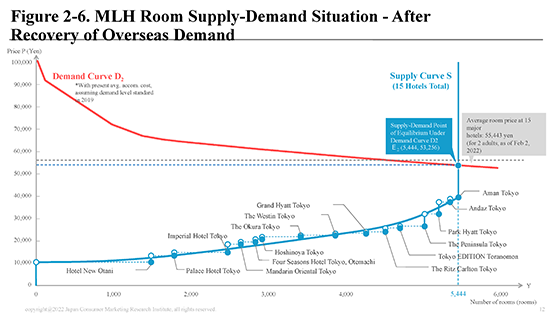
Up to this point, we organized the supply-demand situation for MLH from the perspective of an economic analysis. From here, we will look at solutions from the perspective of business analysis. We will be able to adjust supply and demand based on the future recovery timing of inbound travel, so that we can assume sales of 160 million yen (accommodation costs). However, in the current state of the Covid-19 crisis, regardless of the supply-demand equilibrium point, price competition is unavoidable, and adjustment of supply and demand can't be done. This means that the room for competition, that is, from 10,000 to 55,000 yen, is being adjusted by and between/among hotels. Therefore, sales are estimated to be from 15 million to 82.5 million yen (Figure 2-7).
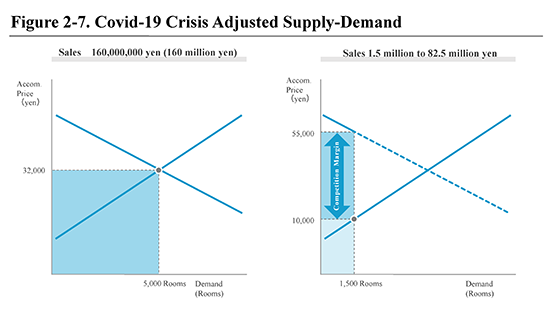
We previously applied a supply-demand analysis of the MLH market but here we attempt a breakeven point analysis from the perspective of each hotel's business. The breakeven point is a concept in accounting and management and is the point at which the amount of sales and cost values are in exact equilibrium. Sales and proceeds that exceed the breakeven point become profit and we are able to visually see the point where sales and costs meet on the breakeven graph.
Firstly, when fixed costs are 60%, the breakeven point with variable costs added is expressed as an occupancy rate of 60-70%. Shown in red is the deficit and in black is the profit (Figure 2-8). When the occupancy rate for each room is currently around 30%, the deficit is large. Hotels' variable costs include linen and amenities, cleaning, which come to 3,000 to 5,000 yen per room at the market price. This amount has become the operation cessation point baseline. In line with this, now that a price competition is underway, the possibility exists that it will drop to this amount if the situation continues to worsen. How can hotels continue their operations and how far can the prices fall will depend on how much of the fixed costs can be borne by owners and shareholders, and if you can cover just the variable costs then you can endure for a little while longer.
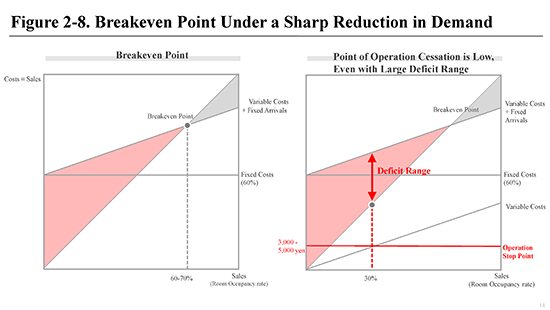
In the breakeven analysis MLH's are taking on a big losses, i.e., large deficits. In this situation, how should hotels be setting their prices? Hotels' accommodation prices are normally decided based on revenue management (Figure 2-9). Revenue management is the process of managing the variations in the price of goods and services in response to customer demand. In concrete terms, by segmenting customers by reservation and setting a different price for each, revenue is maximized. In economics and marketing management this is called pricing strategy.
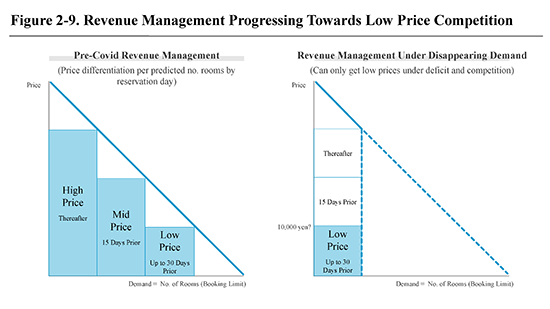
This price setting is the practical application of elements including Littlewood's Three Principles for the maximization of high-priced accommodation customers (mathematical process of distribution to maximize profits from a number of differently priced rooms).
In applying this process, prices set to maximize revenue. The closer together the number of reserved days and number of accommodation days are, the higher the price becomes. However, this is a process that worked well before the Covid-19 crisis but is not applicable now. This is because supply exceeds demand and setting price by reserved day is complicated. There's only one customer segment for maximizing revenue. So, in line with that, one has to choose from among high priced, medium priced and low priced. No matter how low the price is set, if it does not turn a profit, today the enterprise will be unable to escape the pressure to make up as much as possible for the deficit. Thus, there is no theoretical margin for revenue management.
So, in this severe business condition how much is a Afternoon Tea strategy really able to contribute? Focusing on Afternoon Tea sales, JMR estimated and reviewed the data (Figure 2-10).
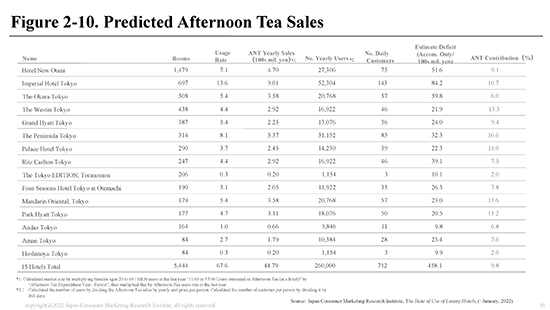
Estimated yearly sales for Afternoon Tea put the Imperial Hotel in first place with 900 million yen, and The Peninsula Tokyo in second place with 540 million yen. Afternoon Tea's rate of contribution towards the estimated deficit is higher at The Peninsula Tokyo, where it still fails to attain the 20% mark. However, it isn't a strategic move to compensate for the deficit of those hotels whose Afternoon Tea initiatives can be seen to contribute to a certain degree of success. With revenue analysis for a single cup of coffee to the details of a menu, we compared what sales raise efficiency. Moreover, if we are to expand the Afternoon Tea operations, funding and investment of about 200 million yen will be required for remodeling facilities and deploying superior human resources.
In conclusion, the Afternoon Tea market is worth capturing. However, for hotels it won't result in offsetting their deficits. We predict at a minimum another 1 or 2 years before the resolution of the Covid-19 crisis and the recovery of domestic demand. So, based on low price competition, accumulated deficit will be 3 to 5 years' worth. While bearing that loss there is no road to prolonged survival besides funding. In line with that, how much funding the parent company is able to do will hold the key to survival. Sunk costs make it too costly to sell off or temporarily close the business, and it is not easy to do away with fixed cost.
So, what should be done? If funding is possible, then there are three strategies for survival. Professor Michael E. Porter of Harvard Business School applies the framework discussed in Competition Strategy. What is important is that 'strategy' isn't simply a new tactic or plan, but it's doing something that other companies can't imitate. This is something that is always a topic and not something that is easy to do.
The first approach is to expand the firm's market share through Cost Leadership. Hotel New Otani and Imperial Hotel realized a low cost and acquired a high share of the low-price competition.
The second method is a differentiation strategy. The development of unique plans and services, differentiation through surpassing a price difference of more than 30% and building a strategy for a competitive edge. Many hotels can't compete on price with these hotels. As regard the 15 hotels, there is a demand for only about 1,500 rooms among the supplied total of 5,444 rooms. Saying that there are about 4,000 surplus rooms is like saying that, based on a hotel having 350 as an average number of rooms, the environment then no longer needs 11 hotels. Seibu Holdings is considering selling off the Prince Hotel and the Odakyu Electric Railway is considering selling off the Shinjuku Hyatt Regency, and if the parent companies of major corporate brands can't raise funds, then the reality is that those hotel groups never will attain stability. In the scramble to win in this competition, firms will end up losing when its plans are unfocused.
The third way is to use a Focused Strategy. This is a method of segmenting specific customer groups and markets, which allows you to fight more successfully and efficiently than your competitors. Examples of this are Aman Tokyo and Hoshinoya Tokyo.

In this way, in a situation where the basis of operations is unstable, firms can't survive just by simply waiting for a recovery of demand. Businesses need to clarify the strategy and redefine the definition and aim (purpose) of a hotel.
For example, New Otani took the following initiatives --* First was to implement low-price competitiveness in ordinary hotel services and adopt a thoroughly designed, low-price strategy.
* Second was to take advantage of the company's own low-price competitiveness and transition towards opening serviced apartments.
* Third was Hotel New Otani Marriage Concierge, which is a consultancy formed between Hotel New Otani and a marriage consultancy. The concept is to position the hotel as a partner for life, from arranged marriage meetings to marriage proposal and from wedding ceremony to anniversary. They are trying to create a demand for banquets and receptions through creating a demand of usage as a wedding hotel.
Although there is some doubts due to vagueness of what is being aimed for, it is clear that the future of hotel operations is undergoing big changes.
In particular, the Afternoon Tea market strategy alone is not enough for MLH to survive. Nevertheless the market for afternoon events and settings that give women an enhanced experience represents a substantial unfulfilled market niche. Hotels that redefine themselves don't have just a nighttime demand for accommodation but have uncovered a Noon demand, and by doing so they greatly expand their opportunities and chances for survival.
Learning from Hotels: Initiatives of Female Consumer Leaders
Overall the MLH are in a critical situation, however they're taking the initiative with Afternoon Tea development. What kind of users are hotels capturing? Focusing on the people using hotel Afternoon Tea, we looked at their attributes (Figure 3-1). In terms of work life stage, unmarried workers with a fulltime job and people raising children make up the largest proportions. For professions, managers and executives and fulltime workers make up the largest proportion. Regarding individual income, both the 4 million to under 6 million yen, and 6 million yen or more categories make up the largest proportions. We estimate that the people using Afternoon Tea are high income women.
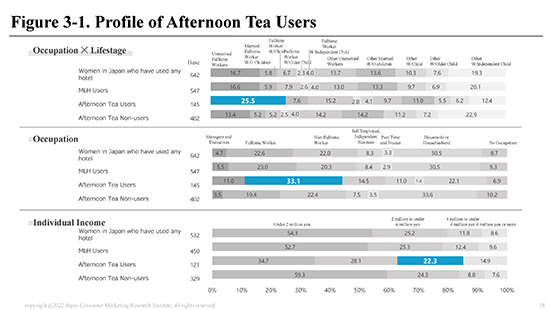
So, in regard to consumption, what do Afternoon Tea users think? The JMR survey results below, show the consumer mindset of Afternoon Tea users. We listed the difference in ratio of consumer mindset between people who have used Afternoon Tea and those who haven't used afternoon tea in descending order (Figure 3-2).
The top three biggest differences are, in first place "I can't spare money to enjoy myself right now", in second place "I can't cut my spending for socializing and dating" and in third place "I think it's safer to choose the product of famous brands". Furthermore, ranking even lower were people who don't use Afternoon Tea with replies of "I should choose the one that's within my means".
Next, let's look at the value mindset of Afternoon Tea users.
The top three are, in first place "I want to acquire social status and fame" at 31%, and tied in second place "I have to have time to socialize" and "I'm concerned about how society views me" both at 28%. The people using Afternoon Tea are women with a strong desire to be in the public eye.
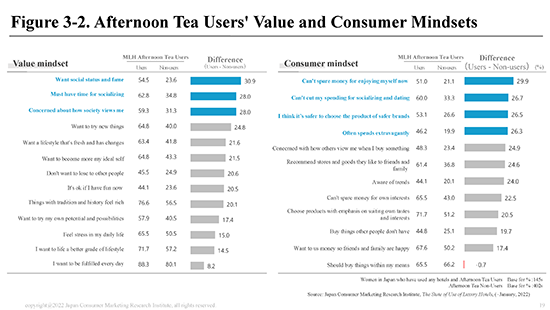
Based on the survey results thus far, we've looked at the attributes of people using Afternoon Tea. One could imagine them elegantly enjoying themselves at a hotel, but their inner psychology is thought to exist with two traits. JMR profiled these traits and offers an interpretation (Figure 3-3).
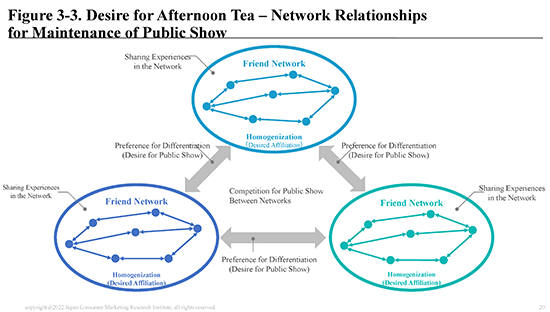
* Desire for Homogeneity
Sharing things like good information and personal experiences with friends in order to be recognized as friends.
They want to establish where they fit in.
This is so-called herd mentality. Normally, having friends around you is believed to bring status, and they want a sense of security.
* Desire for Differentiation
They want to show off their good experiences to those who are not their friends and get a sense of superiority.
They want to be seen as part of the elite.
Seeking to be different than rivals and wanting to have a sense of superiority is thought to be an ingrained sign of an inferiority complex.
The women using Afternoon Tea are using Afternoon Tea as 'relationship capital' to maintain relations with friends. Their aim is to share the same experiences and their own delight likely comes second.
Their basic need here is to obtain a sense of security through homogenization that is achieved by confirming friends' mindset, via having the same experiences. On the other hand, for other groups that they aren't affiliated with, we believe they wish to differentiate themselves by showing off in order get a sense of superiority.
Why do these kinds of friend and herd mentality and the display of a sense of superiority towards other groups occur?
It is due to the economic condition of women being much more severe than that of men. They have lower income than men, and at the same time, this gap is widening. In terms of average yearly income men earn 5.45 million yen while women earn 2.93 million yen (Survey of Private Salary Statistics). Women join companies as non-fulltime employees or become non-fulltime employees from their 30s, due to life-stage events including having children. In line with this, in order to maintain their lifestyle, exchanging information with their friends becomes important, while on the other hand they show off the status that their income represents. Among the friends of these women there is a preference for homogenization and the preference for differentiation from those outside the friend group is stronger than that of men. This is because women are more social, and it is well known that homogenization and differentiation give rise to trends and fads (the Hipster Effect). Thus, the possibility that Afternoon Tea is also a fad is also high. It's not possible to show off when many women have the same experience and that will lead to future new fad as to create 'relationship capital'.
While women using Afternoon Tea have this kind of two-sidedness, they frequently exchange information and that gives rise to a quasi-leader who creates the next fad (Figure 3-3).
To increase the brand power of hotels and sustain continued use, it's important to first get women to experience it. So, we know that the use of Afternoon Tea has sufficient effect on likeability, reviews, and use of accommodation over the use of other facilities. Targeting women that want to show off and have a strong desire to be in the public eye makes them important influencers for Afternoon Tea, and creates a chance that others will start using Afternoon Tea. So, hotels that captive yet uncaptured users of Afternoon Tea and fulfill the experience interval for shared delights from 11:00 to 17:00, can expect to create new value and further expand this market size.
Hotels and restaurants in the MLH arena have been engaged actively in Afternoon Tea initiatives. Although it's been around for a long time, the proper application of afternoon fulfillment needs, making it more splendid, is a way to offset not being able to travel internationally due to Covid-19. This has not escaped the attention of just the 15 hotels that have produced a good result of earning 4.5 billion yen per annum. However, this isn't enough to cover the deficit in the highly MLH competitive marketplace. Every customer-facing firm should be paying attention to the afternoon activities of women. There, somewhere in that magic interval can be found a means of business survival. Learning from this, there are five things we can say to makers of consumer goods.
(1)Target Women with Consumer Leader Power
We learned that the market size of women who want to fulfill their afternoon between 11:00 and 17:00 amounts to just under 7 trillion yen. These women have a desire to be in the public eye, to show off and disseminate information through showing off. These are now our target consumer leaders. What do women want to do between 11:00 and 17:00? By providing products and services that meet this need gets you the chance to very effectively capture this audience.
(2)Target Women's Behavior
The things women want during these hours is: they want a more fulfilling meal, and even just focusing on Afternoon Tea the market size in Japan is 21.9 billion yen. Meanwhile analysts put the market for hit products from food makers as exceeding 10 billion yen. Certainly not a small and one that demands greater attention as urban centers increase.
(3)Target Hours Giving Rise to Activities
In this survey, among the women that are consumer leaders, we can see that housewives are primarily active during weekdays and fulltime workers are primarily active on weekends. Furthermore, higher earners are active more at night than they are during the day. For future research it will be important to research the activity details during the core times when women are effectively active in order to capture their needs.
(4)Invent Differentiated Prices, not Goods and Services
Currently, the needs of the market are changing rapidly due to the Covid-19 crisis. The goods and services deployed until now are inapplicable. And there is the price competition. Whatever kind of price competition it is and whatever becomes the predominant mode within it, there is also the possibility that the situation may change if another enterprise produces differentiated prices. Right now, what's in demand is differentiated prices and so looking as though the situation can be captured by the formula 1+1=2+α. Enterprises might also consider forming a tag-team with a leading luxury hotel that can fulfill the afternoon fulfillment needs.
(5)Combine with Brand Loyalty
Now what's important is dismantling what was common knowledge until now, and perhaps making new segments of categories for market needs. Clarify concepts, refine your customers, and guarantee new brand loyalty with detailed and well-planned strategies together with also getting a renewed understanding of the fresh face of loyalty that's been built up until now.
While hotels compete among themselves MLH have created a 4.5 billion yen market and are endeavoring towards revitalization. While the Afternoon Tea market is expanding, consumer needs are becoming more discerning. More and more we must seriously reform and innovate goods and services, strategies and marketing. Towards that, it is necessary to push forward on the previous 5 points and change them into strategic actions.
High-Resolution Figures and Tables
If you would like high-resolution versions of the figures and tables in the text, please contact us.
-
【Annotation】
- *1 Noon-katsu: neologism meaning "noon-time and activities (Japanese: katsu)
Author Profile
Tomomi Aso
Marketing creator born in the 1980s, Creative Manager of Japan Consumer Marketing Institute.
She became a marketer after working in various industries, specially in hospitality industry. She has a proven track record and reputation in in-store communication, specializing in illustration. She aims at "emotional marketing" to persuade consumers.


![戦略家のための知的羅針盤[エム・ネクスト]product by 松田 久一](/img/mnext-sub-title.png)

